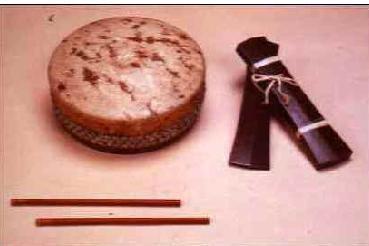How to play the drum
858 views · Organized by 蕾伊 on 2022-02-10
There are two ways of playing the drum, which are static and dynamic.

static
Sit upright, head, neck, chest, waist straight, relax, breathe naturally, and look straight ahead. Step on the small wooden board placed in front of the chair with your right foot, align your right knee with the center of the board drum, and adjust the height of the board drum. The striking part is basically the same as the drum surface. The shoulders and arms are relaxed, the arms do not clip the armpits, the forearms are raised flat, and the hands are placed on the cushioning part of the back of the right knee. The arrows are held together in both hands, and each is slightly buckled inwardly, in the form of a buckle or a circle. The method of holding the arrow with both hands: Use the thumb, index finger, and middle finger to pinch the tail of the drum arrow about an inch at the rear end, press the arrow with the thumb up, and hold the arrow with the index finger and the middle finger, and the five fingers are naturally held together. The thumb and the drum arrow basically form a line. The thumb, index finger, and middle finger should not be too dead when pinching the arrow, as long as it can be flexibly shaken and not easy to let go when hitting. Left-handed board method: The sitting position is the same as the right-handed single arrow method. Place the right hand on the right knee pad. The left hand holds the bottom plate lightly, eating, middle, and nameless, the little finger is held on the outer edge of the bottom plate, the inside of the big thumb joint is against the inner edge of the bottom plate, the thumb is raised and the rope is lifted, and the big thumb joint is stretched out to make the back of the cover plate Just outside of the great thumb joint, the upper end of the bottom plate and the cover plate present an intersection. The point where the bridge tip of the lower end of the bottom plate collides with the bottom of the cover plate is the intersection point. The accuracy of the intersection point is very important for the sound of the castanets. In order to ensure that the intersection point is accurate, the upper end of the base plate must be higher than the upper end of the cover plate, and the intersection point of the lower end can be accurate. In short, when the left hand is on the board, the shoulder should be relaxed, the forearm should be naturally raised forward and flat, do not clamp the armpit, do not drop the elbow, and keep the overall loose and straight.dynamic
When entering the dynamic hitting training, on the basis of the static requirements, keep the static posture and method for strict hitting training. Mastering the normative requirements of the static style can better ensure the dynamic training, and further master the methods and essentials of the dynamic style; through the strict training of the dynamic style, the static style can be continuously proficient, consolidated and deepened. The two are dialectical relations. Static and dynamic are integrated, and finally achieve the purpose of mastering the correct posture and technique of playing the drum. The method and essentials of hitting the arrows with both hands: the padding part of the right knee with both hands. Raise your wrists, stand your hands, lift your arrows, and alternately swing the two arrows down to hit the drum door, making it sound even and crisp.Involving musical instruments
Bangu (Pinyin: bǎn gǔ) is a kind of percussion instrument, also known as Mingpi and Bangu. The "Jiegu" used in Qing music in the Tang Dynasty may be its predecessor. It has a long history in the folk. The "Continued Documents of the Qing Dynasty" contains: "The bangu, also known as the drum, has an urgent sound and chews, and is the leader of each utensil, and it is not easy to strike." It is the conductor instrument in the Chinese opera orchestra.
Guess you like
Organized by 天井 on 2022-02-10
The important part of the drum should be kept moist, and the drum skin should not be scratched when retracting, otherwise the drum skin will be broken due to changes in humidity.
read >>
Organized by Fucui on 2022-02-10
Raise your wrists and stand your hands, and lift your arrows to the direction of your eyes to hit the drums. Avoid splitting the arrows too far to the sides or merging inwards when shooting. Always be upright, natural, hit straight, and drop forcefully. The moment after the arrow is dropped and the drum is beaten, it is still necessary to maintain the buckle style.
read >>
Organized by 湛鹰 on 2022-02-10
The board drum is a percussion instrument, also known as the sheet music and the ban drum. The "Jiegu" used in Qing music in the Tang Dynasty may be its predecessor. It has a long history in the folk. The "Continued Documents of the Qing Dynasty" contains: "The bangu, also known as the drum, has an urgent sound and chews, and is the leader of each utensil, and it is not easy to strike." Chang and Clapboard are named after one person plays both, and it is the conductor instrument in the Chinese opera orchestra. As early as the Tang Dynasty (618-907), it was used in "Qing Yue", and it was called "Jiegu" at that time.
read >>
 渝公网安备 50010702504639号
渝公网安备 50010702504639号